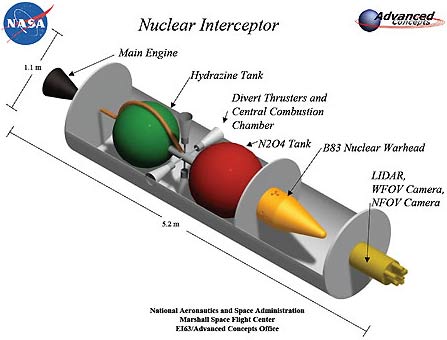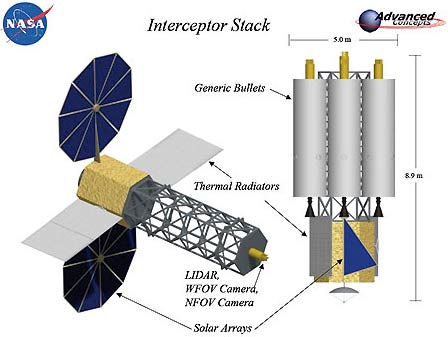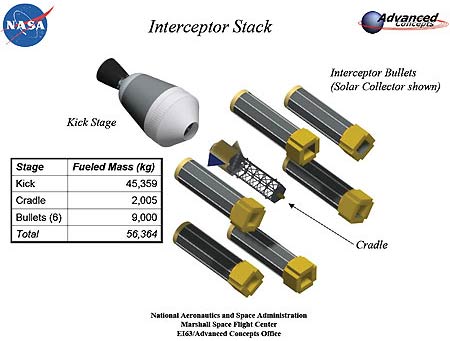NASA: Deflect meteorites with nuclear weapons
Quang Thinh
Under NASA's new plan, missiles with nuclear warheads will be used to deflect meteorites capable of hitting Earth. This plan can be implemented in 2020 or 2021.
As the latest effort by the US Aeronautics and Space Agency (NASA) to save the Earth at the risk of colliding with cosmic objects, this plan is built on an idea given at the Society. planet protection conference in Washington DC in March this year.
Use 6 nuclear warheads B83
Since a prediction of the asteroid Apophis could hit Earth in 2036 with a probability of 1 / 45,000, NASA has been constantly considering solutions to deflect meteorites, but it seems they haven't yet. satisfied with any solution.

Each missile has a B83 1 megaton nuclear warhead, equivalent to 1 million tons of TNT (Photo: NASA)
Recently, the team from NASA's Marshall Space Travel Center proposed a new plan: using a spacecraft to create a nuclear explosion to deflect meteorites. Under this method, a spacecraft called ' asteroid deflector ' (asteroid deflector) will be launched from Earth's low orbit with Ares V missiles - the new generation of missiles of NASA.
When approaching the meteorite, the spacecraft will in turn release 6 interceptors - at the top of each rocket with a B83 1 megaton nuclear warhead (equivalent to 1 million tons of TNT). Each missile will be fired 1 hour apart. These warheads will be detonated one by one near the surface of the meteorite, creating enough thrust to make it slip out of the dangerous orbit for the Earth.
According to the research team, these six nuclear warheads are capable of pushing an asteroid-sized object like Apophis (more than 300 meters in diameter).


Act 2 - 5 years before a collision occurs
According to NASA, by the 2020s, the 'interceptor missile solution could deflect objects near Earth (NEO) with a diameter of 100 - 500 meters at two years before the collision could occur. out; for larger NEO, this time will be at least 5 years'.

Solution using interceptor missiles can deflect NEO with a diameter of 100-500 meters at 2 years before the collision can occur.(Photo: Crystalinks.com)
In recent years, the discovery of some potentially dangerous asteroids on Earth has prompted the international community to develop a concept called 'Restricting the effects of objects near the Earth'. , which specifically deflects meteorites capable of threatening the Earth.
Notably, in June 2002, an asteroid moved across the Earth at a distance of one-third the distance from the Earth to the Moon, but it took three days after the event occurred. New scientists know!
According to the team, this plan may be the last and best solution to deflect the orbits of solid meteorites for a short time before they hit the planet.
Other solutions have also been considered, such as blowing up meteorites or concentrating the sun's rays to create thrust, but these solutions are either unsafe or take too much time to implement.
According to Flight Global, Fox News, Engadget, VietNamNet
- NASA considered using nuclear weapons against the apocalypse
- Russia and the United States started to work on anti-meteor weapons
- How will nuclear weapons return Earth back to its original time?
- The most feared nuclear weapons systems in the world
- Deflect meteorites with ... mirrors
- The crazy idea of using nuclear weapons in history
- How will nuclear war destroy Earth?
- 9 ways to block meteorites
- Earth temperature may change because of nuclear war
- America uses nuclear weapons to protect the Earth from meteors
- What horrible happens if Russian-American nuclear war?
- The world's first underwater nuclear explosion
 Van Allen's belt and evidence that the Apollo 11 mission to the Moon was myth
Van Allen's belt and evidence that the Apollo 11 mission to the Moon was myth The levels of civilization in the universe (Kardashev scale)
The levels of civilization in the universe (Kardashev scale) Today Mars, the sun and the Earth are aligned
Today Mars, the sun and the Earth are aligned The Amazon owner announced a secret plan to build a space base for thousands of people
The Amazon owner announced a secret plan to build a space base for thousands of people